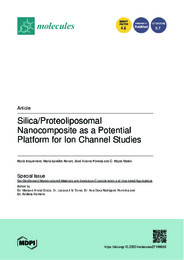Por favor, use este identificador para citar o enlazar este ítem:
https://hdl.handle.net/11000/30731
Silica/Proteoliposomal Nanocomposite as a Potential Platform for Ion Channel Studies
Título :
Silica/Proteoliposomal Nanocomposite as a Potential Platform for Ion Channel Studies |
Autor :
Esquembre, Rocío 
Renart, María Lourdes 
Poveda, José Antonio
Mateo , C. Reyes  |
Editor :
MDPI |
Departamento:
Departamentos de la UMH::Agroquímica y Medio Ambiente |
Fecha de publicación:
2022-10-05 |
URI :
https://hdl.handle.net/11000/30731 |
Resumen :
The nanostructuration of solid matrices with lipid nanoparticles containing membrane proteins is a promising tool for the development of high-throughput screening devices. Here, sol-gel silica-derived nanocomposites loaded with liposome-reconstituted KcsA, a prokaryotic potassium channel, have been synthesized. The conformational and functional stability of these lipid nanoparticles before and after sol-gel immobilization have been characterized by using dynamic light scattering, and steady-state and time-resolved fluorescence spectroscopy methods. The lipid-reconstituted KcsA channel entrapped in the sol-gel matrix retained the conformational and stability changes induced by the presence of blocking or permeant cations in the buffer (associated with the conformation of the selectivity filter) or by a drop in the pH (associated with the opening of the activation gate of the protein). Hence, these results indicate that this novel device has the potential to be used as a screening platform to test new modulating drugs of potassium channels.
|
Palabras clave/Materias:
immobilization
ion channel
nanostructured materials
proteoliposomes
silica-matrices |
Área de conocimiento :
CDU: Ciencias puras y naturales: Química |
Tipo documento :
application/pdf |
Derechos de acceso:
info:eu-repo/semantics/openAccess
Attribution-NonCommercial-NoDerivatives 4.0 Internacional |
DOI :
https://doi.org/10.3390/molecules27196658 |
Aparece en las colecciones:
Artículos Agroquímica y Medio Ambiente
|
 La licencia se describe como: Atribución-NonComercial-NoDerivada 4.0 Internacional.
La licencia se describe como: Atribución-NonComercial-NoDerivada 4.0 Internacional.
 La licencia se describe como: Atribución-NonComercial-NoDerivada 4.0 Internacional.
La licencia se describe como: Atribución-NonComercial-NoDerivada 4.0 Internacional.
.png)
